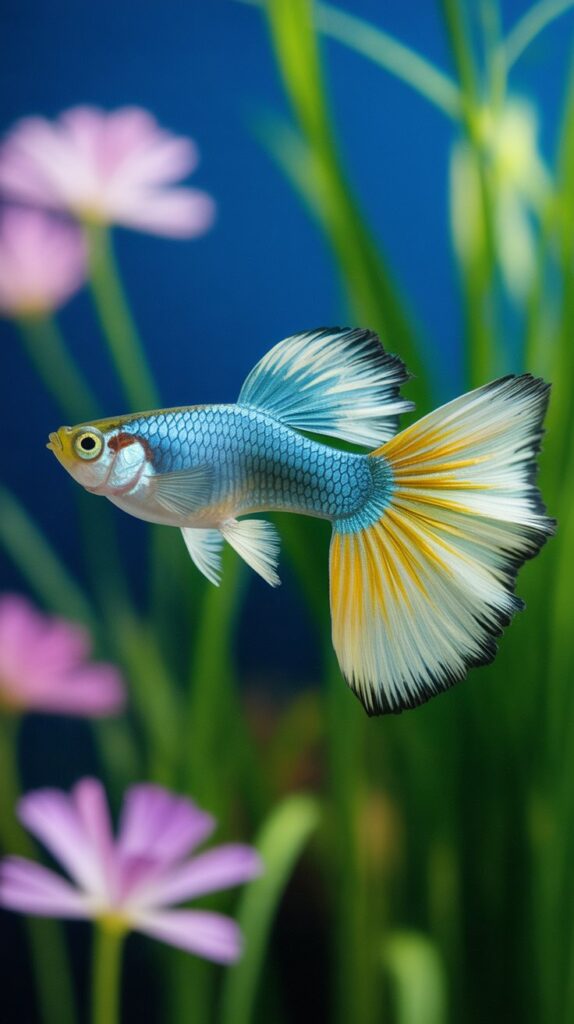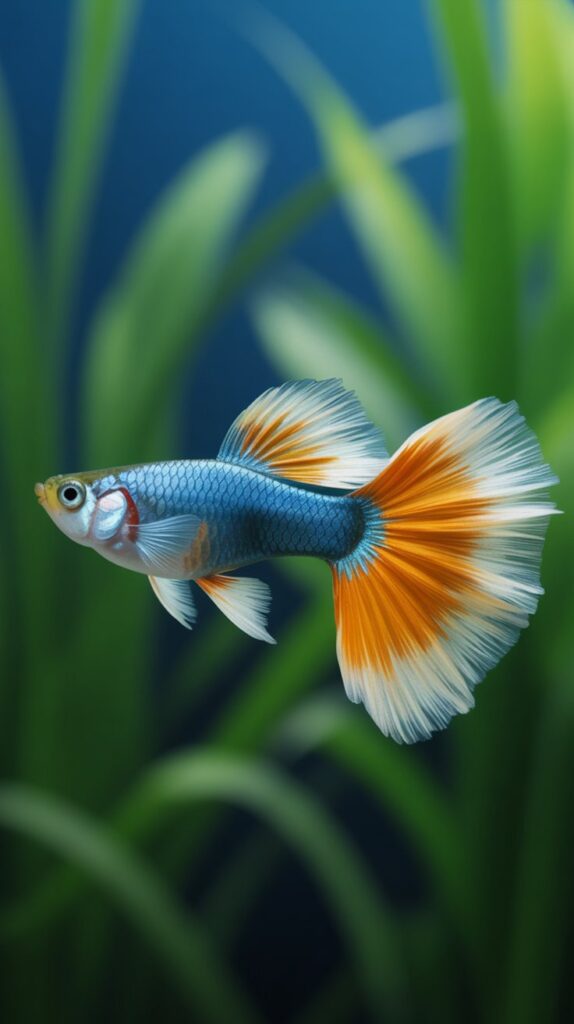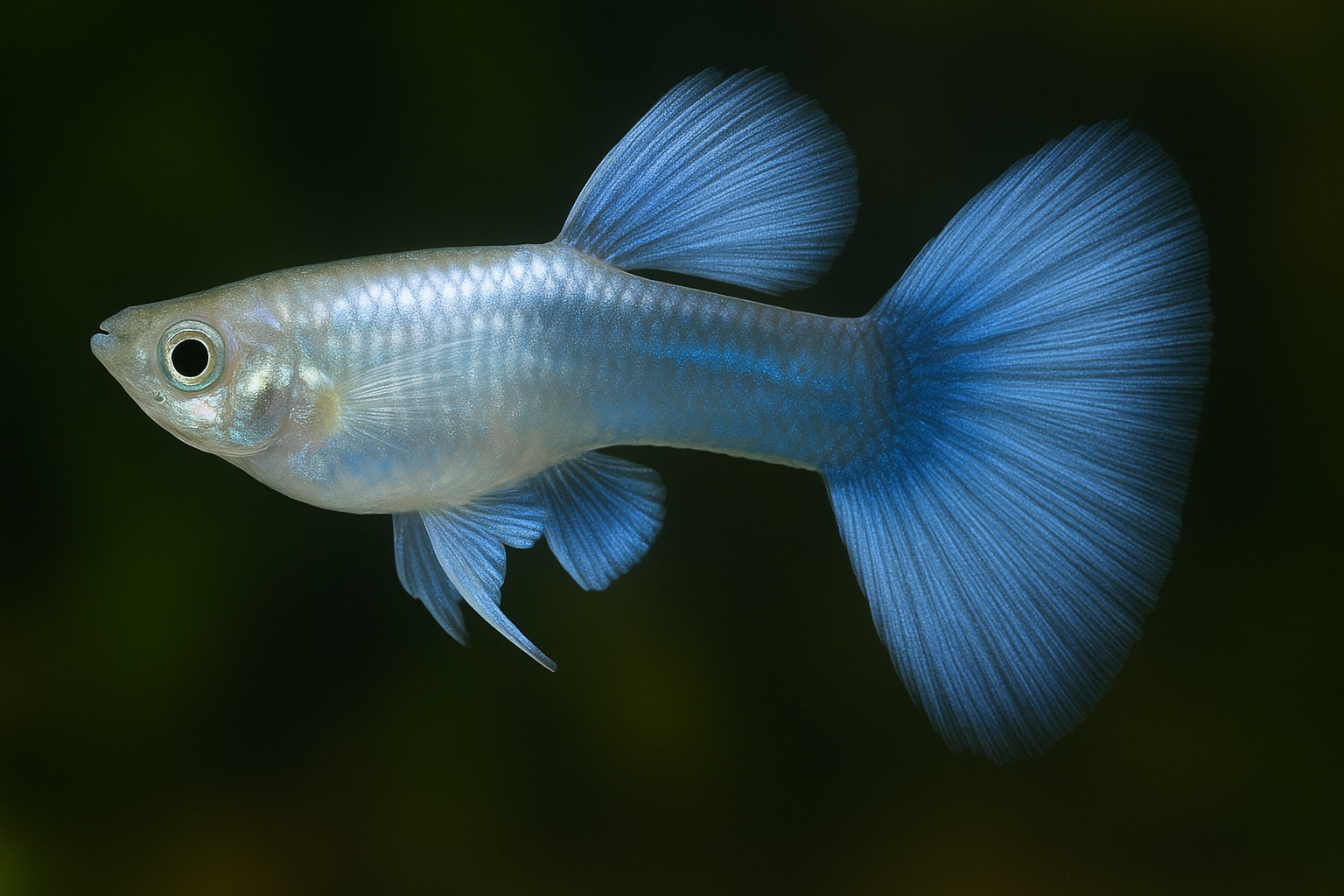The Platinum Blue Guppy is one of the most stunning and sought-after guppy varieties in the ornamental fish trade. Known for its shimmering silver-blue body and graceful fin movement, this guppy is not only visually striking but also hardy and relatively easy to care for. Whether you are a beginner or an experienced aquarist, the Platinum Blue Guppy offers the perfect blend of beauty and adaptability.
In this comprehensive guide, we will cover everything about the Platinum Blue Guppy — from its origins, physical characteristics, and tank requirements to breeding, diet, and common health issues. By the end, you’ll know exactly how to keep these dazzling fish healthy, happy, and breeding successfully.
Origins and History of the Platinum Blue Guppy
The guppy (Poecilia reticulata) originates from South America, particularly in the freshwater streams and rivers of countries like Venezuela, Guyana, and Trinidad. Over time, guppies were introduced to aquariums worldwide due to their vibrant colors and adaptability.
The Platinum Blue Guppy is not found in the wild in this exact form — it is a selectively bred strain created by expert breeders. By crossing metallic platinum-colored guppies with blue variants, aquarists developed a fish with a reflective silver body and deep blue hues in the fins and tail.
This selective breeding not only enhanced the guppy’s beauty but also retained its hardy genetics, making it a favorite among hobbyists and commercial breeders.
Physical Characteristics

1. Body Color
The Platinum Blue Guppy has a metallic platinum sheen that reflects light beautifully, making it appear almost iridescent. The body often has a bluish tinge, especially near the tail and dorsal fin.
2. Fin Types
They are available in various tail shapes, including:
- Delta Tail
- Veil Tail
- Round Tail
- Ribbon Tail
Each tail type further enhances their graceful swimming style.
3. Size
- Males: 1.5 – 2 inches (3.8 – 5 cm)
- Females: 2 – 2.5 inches (5 – 6.3 cm)
4. Sexual Dimorphism
- Males: More colorful, smaller, and have larger tails.
- Females: Larger bodies, duller coloration, and rounded fins.
Behavior and Temperament
Platinum Blue Guppies are peaceful, social, and active swimmers. They thrive best in groups of six or more, as they feel more secure and display more natural behavior in a shoal.
- Compatible tank mates: Neon tetras, mollies, swordtails, platies, and other peaceful species.
- Avoid aggressive fish: Such as bettas, large cichlids, and tiger barbs, which may nip their fins.
They are also known for being curious and will explore every corner of the tank.
Tank Setup for Platinum Blue Guppies

1. Tank Size
A 10-gallon tank is the minimum for a small group, but a 20-gallon tank offers more space and stability for water parameters.
2. Water Parameters
- Temperature: 72°F – 82°F (22°C – 28°C)
- pH: 6.8 – 7.8
- Hardness: 8 – 12 dGH
- Ammonia/Nitrite: 0 ppm
- Nitrate: Below 20 ppm
3. Filtration
A gentle sponge filter or hang-on-back filter is recommended to keep the water clean without creating strong currents.
4. Lighting
Moderate lighting will enhance their platinum and blue tones. LED lights with adjustable intensity work best.
5. Substrate
Fine gravel or sand substrate works well. The choice often depends on whether you plan to keep live plants.
6. Decorations and Plants
Platinum Blue Guppies love a mix of open swimming areas and hiding spots.
- Live plants: Java moss, anubias, hornwort, and guppy grass.
- Decorations: Smooth rocks, driftwood, and caves.
Diet and Feeding
Platinum Blue Guppies are omnivorous, requiring a mix of plant-based and protein-rich foods.
Recommended Diet:
- High-quality flakes or pellets – Specifically formulated for tropical fish.
- Live foods – Brine shrimp, daphnia, and mosquito larvae.
- Frozen foods – Bloodworms, mysis shrimp.
- Vegetables – Blanched spinach, cucumber slices, and zucchini.
Feeding frequency: 2–3 times a day in small portions to avoid overfeeding and water pollution.
Breeding Platinum Blue Guppies

One of the biggest attractions of keeping guppies is their prolific breeding habits.
1. Sex Ratio
Keep one male for every two or three females to prevent excessive stress on females.
2. Breeding Tank Setup
- Tank size: 5–10 gallons
- Plants: Provide dense plants like java moss for fry to hide.
- Temperature: Around 78°F (25.5°C) to encourage breeding.
3. Gestation
Female Platinum Blue Guppies are livebearers, meaning they give birth to free-swimming fry instead of laying eggs. Gestation lasts 21–30 days.
4. Fry Care
- Feed newly hatched brine shrimp, micro worms, or powdered fry food.
- Keep fry separate from adults to avoid predation.
Common Health Issues
Even though Platinum Blue Guppies are hardy, they can still suffer from common aquarium diseases.
- Ich (White Spot Disease) – Treat with aquarium salt and appropriate medications.
- Fin Rot – Usually caused by poor water quality; treat with antibacterial remedies.
- Swim Bladder Disorder – Often linked to overfeeding; fasting can help.
- Fungal Infections – Appear as cotton-like growth; treat with antifungal medication.
Prevention Tips:
- Maintain good water quality.
- Avoid overstocking.
- Quarantine new fish before adding them to the main tank.
Why Choose the Platinum Blue Guppy?

- Striking appearance – Metallic platinum and deep blue tones.
- Hardiness – Adapts to a range of conditions.
- Breeding ease – Perfect for beginners wanting to breed fish.
- Peaceful nature – Suitable for community tanks.
- Affordability – Readily available at reasonable prices.
Maintenance Tips for a Healthy Aquarium
- Weekly Water Changes – Replace 20–30% of the water.
- Gravel Cleaning – Use a siphon to remove waste.
- Filter Maintenance – Rinse filter media in tank water monthly.
- Monitor Water Parameters – Test weekly to ensure stability.
- Observe Fish Behavior – Early detection of illness improves recovery chances.
Conclusion
The Platinum Blue Guppy is an ideal choice for aquarists of all experience levels. With their shimmering silver-blue appearance, peaceful temperament, and easy care requirements, they can transform any aquarium into a vibrant underwater display. By providing the right environment, balanced diet, and proper maintenance, you can enjoy their beauty and watch them thrive for years.
FAQs About Platinum Blue Guppy
Q1: How long do Platinum Blue Guppies live?
A: They typically live 2–3 years with proper care, though some can live longer in optimal conditions.
Q2: Can Platinum Blue Guppies live with bettas?
A: While possible, it’s risky. Bettas may attack guppies due to their bright colors and flowing fins.
Q3: How often should I feed them?
A: 2–3 times a day in small amounts that they can consume within 2 minutes.
Q4: Do Platinum Blue Guppies need a heater?
A: Yes, if your room temperature is below 72°F. A heater ensures stable tropical conditions.
Q5: How many Platinum Blue Guppies can I keep in a 10-gallon tank?
A: A small group of 6 is suitable, considering one inch of fish per gallon as a general rule.
Q6: Can I breed Platinum Blue Guppies with other guppy types?
A: Yes, but this will result in mixed offspring, not pure Platinum Blue strains.

